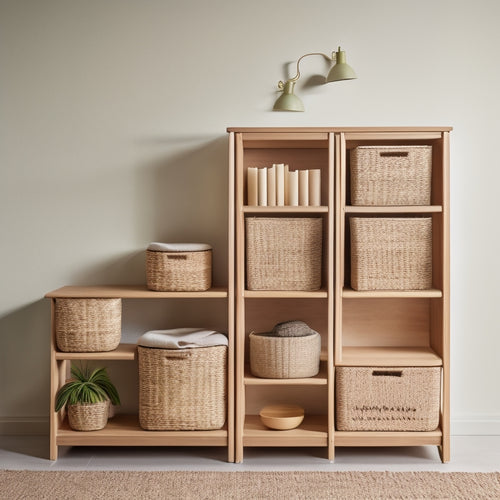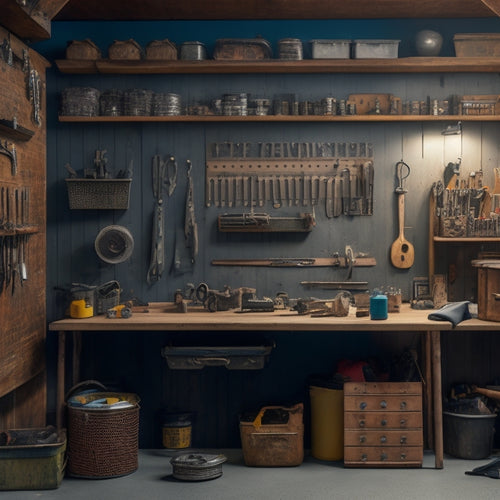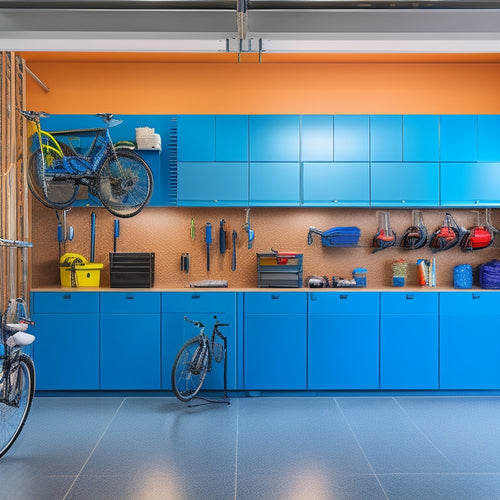
How to Build the Ultimate Power Tool Shelf
Share
You're about to create a power tool shelf that's customized to your unique needs and workflow. First, plan the perfect layout, considering ergonomic design, tool weight, and accessibility. Next, choose durable materials and essential tools, like plywood, lumber, and a drill press. Build a sturdy frame and base, then add adjustable shelving and dividers to accommodate varying tool sizes. Install holders and hooks, and incorporate a cord management system to keep your workspace organized and safe. From there, you'll be well on your way to crafting the ultimate power tool shelf - and with a few more steps, you'll be ready to tame the chaos in your workshop.
Key Takeaways
- Plan the perfect power tool layout by prioritizing ergonomic design, heavier tools at the bottom, and similar tools grouped together.
- Choose durable materials like 3/4-inch plywood or MDF for shelves and 2x4 lumber for the frame to support tool weight.
- Build a sturdy shelf frame and base using 2x4 lumber, ensuring accurate measurements and evenness for safe tool storage.
- Add adjustable shelving and dividers to accommodate varying tool sizes and organize similar tools for efficient storage.
- Incorporate cord management systems, such as cord clips and reels, to prevent clutter and reduce safety hazards in the workspace.
Planning the Perfect Power Tool Layout
With your power tool collection growing, it's essential to plan a layout that maximizes storage and accessibility. A well-planned layout guarantees you can quickly find the tool you need, reducing frustration and increasing productivity.
Consider the ergonomic design of your shelf, taking into consideration the height and reach of your most frequently used tools. Place them at a comfortable height to avoid straining your back or shoulders.
Think about tool accessibility, too. Store heavier tools at the bottom to prevent them from falling and causing injury. Group similar tools together, such as drills and drivers, to simplify your workflow.
Leave enough space between each tool to prevent overcrowding and make it easy to grab what you need. Consider a pegboard or hook system for hanging tools like saws and sanders, keeping them organized and out of the way.
Choosing the Right Materials and Tools
Now that you've planned your power tool layout, it's time to select the materials and tools that will bring your design to life. When choosing materials, prioritize durability and strength to guarantee your shelf can support the weight of your power tools. Consider using 3/4-inch plywood or medium-density fiberboard (MDF) for the shelves and 2x4 lumber for the frame.
For tools, think about compatibility and versatility. You'll need a drill press, circular saw, and jigsaw for cutting and drilling. A tape measure, level, and clamps will help with assembly. Don't forget safety gear like gloves, safety glasses, and a dust mask.
| Material/Tool | Considerations |
|---|---|
| Plywood/MDF | Material durability, weight capacity |
| Drill press | Tool compatibility, precision drilling |
| Safety glasses | Eye protection, lens clarity |
| Clamps | Grip strength, adjustability |
Remember to check the specifications of each material and tool to guarantee they meet your project's requirements. With the right materials and tools, you'll be well on your way to building a sturdy and functional power tool shelf.
Building the Shelf Frame and Base
Your power tool shelf's frame and base are its backbone, providing the structural integrity to hold your essential tools. A sturdy frame guarantees your tools are safely stored and easily accessible.
To build a durable frame, start by determining your shelf dimensions based on the space available and the tools you need to store.
When constructing the frame, prioritize frame stability by:
- Using 2x4 lumber for the legs and shelves to provide a solid foundation.
- Assembling the frame with screws instead of nails for added strength.
- Confirming the shelves are level and securely attached to the frame to prevent sagging or collapsing.
Remember to measure twice and cut once to avoid errors. Use a carpenter's square to verify the corners are square and the frame is even.
Adding Adjustable Shelving and Dividers
You'll want to contemplate adding adjustable shelves to accommodate power tools of varying sizes, ensuring you can store and access them efficiently.
Adjustable shelf options include telescoping shelves, slotted shelves, or shelves with removable pins.
Meanwhile, shelf dividers can keep similar tools organized and prevent clutter, with ideas ranging from simple wooden strips to customized inserts.
Adjustable Shelf Options
Building adjustable shelves and dividers into your power tool shelf allows for maximum flexibility and customization.
You'll be able to accommodate tools of varying sizes and weights, and easily reconfigure your shelf as your needs change.
When designing your adjustable shelf options, reflect on the following key factors:
-
Shelf height: Adjustable shelves should allow you to customize the height of each shelf to fit tools of different sizes, from compact drills to larger saws.
-
Weight capacity: Verify that your adjustable shelves can support the weight of your heaviest tools, considering the weight capacity of the shelf and its materials.
-
Ease of adjustment: Choose a design that allows for easy adjustment of shelf height and dividers, so you can quickly reconfigure your shelf as needed.
Shelf Divider Ideas
Five clever shelf divider ideas can help you maximize your power tool shelf's storage potential. By incorporating dividers, you'll prevent tools from getting jumbled, make it easier to find what you need, and maintain a safe working environment.
You can use wooden or plastic dividers, depending on your shelf's aesthetics and the tools you're storing. For instance, wooden dividers can complement a wooden shelf, while plastic dividers are better suited for metal or composite shelves.
Consider adjustable dividers that can be moved as your tool collection grows or changes. These can be made from metal or PVC pipes with attached brackets.
Another idea is to use baskets or bins as dividers. Label each basket to identify the tools stored within. This is especially useful for small items like drill bits, screws, or nuts.
You can also use stackable containers or shelves with built-in dividers to create separate compartments for different tools. Whatever divider material you choose, make certain it's sturdy enough to hold the weight of your tools and won't topple over.
Installing Power Tool Holders and Hooks
As you move forward with organizing your power tool collection, installing power tool holders and hooks becomes an essential step in maximizing your shelf's storage capacity.
This will enable you to store your tools in an efficient and accessible manner, guaranteeing shelf stability and tool accessibility.
When selecting power tool holders and hooks, consider the following factors:
-
Tool size and weight: Choose holders and hooks that can accommodate the size and weight of your tools to prevent them from falling or becoming dislodged.
-
Shelf material: Verify the holders and hooks are compatible with your shelf material to prevent damage or corrosion.
-
Ease of use: Opt for holders and hooks that allow for easy tool removal and replacement to save time and effort.
Incorporating Cord Management Systems
Your power tool shelf is taking shape, and now it's time to tackle the often-overlooked but essential aspect of cord management. A cluttered mess of cords can be a safety hazard, causing tripping accidents and making it difficult to find the right tool when you need it. To avoid this, incorporate cord organization techniques into your shelf design.
Consider installing cable management solutions such as cord clips, cable ties, or zip ties to keep cords organized and out of the way. You can also use cord reels or cord wraps to keep cords tidy when not in use.
Another option is to install a cord organizer system, which typically consists of a series of hooks and clips that keep cords organized and easily accessible. Whichever method you choose, make sure it's easy to use and maintain, so you'll actually use it.
With a well-planned cord management system, you'll be able to quickly find the tool you need, and your workshop will be a safer, more efficient space.
Organizing Small Parts and Accessories
By now, you've got your power tools organized and your cords managed, but what about all the small parts and accessories that come with them?
These tiny components can easily get lost or misplaced, causing frustration and wasting precious time.
To keep them organized, consider using storage bins, label systems, and drawer organizers. These will help you categorize and store small parts, such as screws, nuts, and bolts, in a way that makes sense for your workflow.
Here are three essential items to include in your small parts storage system:
-
Clear containers: Use transparent bins or containers to store small parts, making it easy to see what's inside without having to dig through.
-
Magnetic strips: Attach magnetic strips to your tool caddies or compartment boxes to store small metal parts, such as drill bits or saw blades.
-
Color coding: Implement a color-coding system to differentiate between similar parts or categorize them by project type, making it easier to find what you need quickly.
Adding a Pegboard and Accessories
With your small parts and accessories neatly organized, it's time to turn your attention to maximizing the vertical space in your workshop or garage by adding a pegboard and accessories. This won't only keep your frequently used tools within easy reach but also free up precious floor and bench space.
One of the pegboard benefits is its versatility, allowing you to customize it to fit your specific needs. You can hang items like hammers, screwdrivers, and pliers, as well as larger equipment like power drills and saws.
When selecting accessory options, consider the types of projects you typically work on and the tools you use most often. Look for pegs and hooks specifically designed for the items you want to hang, and don't be afraid to mix and match different sizes and styles to create a customized system.
Make sure to securely attach the pegboard to the wall or a sturdy frame to prevent it from tipping over and causing accidents. With a well-planned pegboard and accessories, you'll be able to work more efficiently and safely, and enjoy a more organized workshop or garage.
Finishing Touches and Final Assembly
As you near the completion of your power tool shelf, it's essential to focus on the finishing touches that will enhance its functionality and visual appeal.
This stage is where you can get creative with shelf finish options, such as applying a wood stain, polyurethane, or paint to match your workshop's aesthetic.
Before final assembly, verify all components are properly aligned and securely attached.
Here are three key considerations:
- Double-check your measurements: Verify that all shelves, brackets, and accessories are properly spaced and aligned to avoid any obstructions or interference.
- Tighten all screws and bolts: Make sure all fasteners are securely tightened to prevent any shifting or collapse during use.
- Add any final accessories: Install any remaining accessories, such as hooks, bins, or labels, to maximize your shelf's storage capacity and functionality.
Frequently Asked Questions
Can I Customize the Shelf to Fit My Specific Power Tool Collection?
You can customize the shelf to fit your specific power tool collection by adjusting shelf dimensions to accommodate unique tool sizes, ensuring easy tool accessibility and a safe working environment.
How Do I Prevent the Shelf From Becoming Too Cluttered and Disorganized?
As you envision your tool sanctuary, imagine a chaotic storm of cords and wrenches - then, take control! You'll prevent clutter by implementing tool organization tips, such as categorizing tools by function, and incorporating shelf design strategies like dividers and labeled bins.
Are There Any Safety Considerations When Building a Power Tool Shelf?
When building a shelf, you'll want to evaluate safety by choosing shelf materials that can support the weight capacity of your power tools, ensuring a sturdy structure that won't collapse or tip over, and keeping heavy items at the bottom for stability.
Can I Add a Locking System to Secure My Power Tools?
When it rains, it pours, and securing your power tools is essential. You can add a locking system to your shelf using various locking mechanisms, ensuring your tools are safe and sound, regardless of the shelf materials you've chosen.
How Often Should I Clean and Maintain My Power Tool Shelf?
You should clean your power tool shelf every 1-2 weeks, depending on usage, and perform deeper maintenance monthly, checking for dust, rust, and worn components, to guarantee safety and optimize tool performance.
Conclusion
You've crafted a power tool sanctuary, where every gadget and gizmo has its designated spot, and chaos is a distant memory. Your Ultimate Power Tool Shelf is a harmony of organization, where each component harmonizes with the next, creating a workflow that's as smooth as silk. Now, get ready to release your inner DIY rockstar, as you tackle projects with ease, precision, and a sense of satisfaction that comes from having a workspace that's truly customized to your needs.
Related Posts
-

Open Storage Bins for Shelving Units
You need open storage bins that integrate seamlessly with your shelving units to boost your organization, productivit...
-

Design Considerations for a Custom Pegboard
When designing a custom pegboard, you'll want to start by evaluating your storage needs, considering factors like too...
-

Top Garage Storage Bins for Organization and Style
You can enhance your garage's style and organization with the right storage bins. Top brands like Rubbermaid, Suncast...


